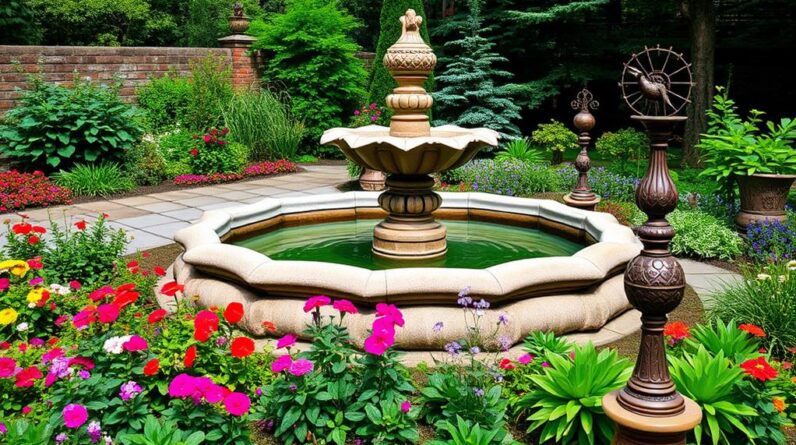
Welcome to the world of vertical gardening, where creativity and cultivation collide!
In this article, we’ll delve into the fascinating realm of vertical gardening, unveiling the techniques and secrets that make it thrive.
Discover how to transform your limited space into a verdant paradise, using innovative systems and savvy design.
From choosing the right plants to troubleshooting common issues, we’ve got you covered.
So get ready to elevate your gardening game and unlock the potential of your vertical oasis!
Key Takeaways
- Vertical gardening is a space-saving technique that allows for growing a variety of plants in limited areas, making it ideal for small spaces and indoor gardening.
- Vertical gardening increases crop yield by maximizing planting density and light exposure, leading to higher overall yield and healthier crops.
- Vertical gardening improves air circulation and reduces the risk of diseases and pests, making it a beneficial technique for maintaining plant health.
- Essential tools and materials for vertical gardening include pruning shears, a drip irrigation system, plant ties, garden gloves, a hand trowel, a sturdy support structure, high-quality soil mix, and a reliable irrigation system.
Types of Vertical Gardening Systems
Explore the various types of vertical gardening systems and discover which one suits your needs and space constraints.
Vertical gardening systems come in different forms, each with its own unique features and benefits.
One popular type is the vertical wall garden, which consists of modular panels that can be easily installed on any wall surface. These panels have pockets or slots where plants can be grown, allowing you to maximize your vertical space.
Another option is the vertical tower garden, which is a freestanding structure that features multiple tiers for planting. This system is ideal for small spaces and can be easily moved around.
Additionally, there are vertical hydroponic systems that use nutrient-rich water to grow plants without soil. These systems are perfect for indoor gardening and provide a controlled environment for optimal plant growth.
Whatever your needs and preferences, there’s a vertical gardening system that can help you create a beautiful and productive garden in even the smallest of spaces.
Benefits of Vertical Gardening
Vertical gardening offers numerous benefits that make it an attractive option for both experienced gardeners and beginners.
One of the main advantages is its space-saving nature, allowing you to grow a wide variety of plants even in limited areas. By utilizing vertical space, you can maximize your garden’s potential and increase your crop yield.
This technique is particularly useful for urban dwellers or those with small yards, enabling them to enjoy fresh produce without the need for a traditional garden plot.
Space-Saving Gardening Technique
Maximize your garden’s potential by utilizing vertical gardening, which allows you to grow plants upwards and save space at the same time. This space-saving gardening technique is perfect for those who desire innovation in their gardening practices.
With vertical gardening, you can make the most of limited space by growing plants vertically on walls, trellises, or even hanging baskets. By doing so, you not only optimize the use of space but also create a visually appealing display.
Besides saving space, vertical gardening also offers other benefits. It allows for better air circulation around the plants, reducing the risk of diseases. It also makes watering and harvesting easier, as plants are within easy reach.
Embrace vertical gardening and transform your garden into a thriving oasis, even in limited spaces.
Increased Crop Yield
Can you enhance your crop yield through vertical gardening, and how does it work?
Vertical gardening is a space-saving gardening technique that not only maximizes the use of limited space but also increases crop yield. Here are five benefits of vertical gardening that can significantly enhance your crop yield:
- Increased planting density: By growing plants vertically, you can grow more plants in a smaller area, maximizing the use of space and increasing the overall yield.
- Improved light exposure: Vertical gardens can be positioned to optimize sunlight exposure, ensuring that all plants receive adequate light for photosynthesis, leading to healthier and more productive crops.
- Better air circulation: Vertical gardens allow for better air circulation, reducing the risk of diseases and pests, resulting in higher crop yield.
- Efficient water usage: Vertical gardening systems often incorporate drip irrigation, which delivers water directly to the plants’ roots, minimizing water waste and ensuring plants receive the necessary moisture for optimal growth.
- Easy access and maintenance: Vertical gardens are designed for easy access, making it convenient to tend to plants, harvest crops, and perform regular maintenance tasks, ultimately leading to higher crop yield.
With these benefits, vertical gardening offers an innovative and efficient approach to enhance your crop yield, making it an ideal choice for those seeking to optimize their garden’s productivity.
Essential Tools and Materials for Vertical Gardening
When it comes to vertical gardening, having the right tools and materials is crucial for success.
From must-have gardening tools like pruners and trowels to essential materials such as trellises and planters, these items will help you maximize your vertical growing space and ensure healthy plant growth.
Must-Have Gardening Tools
You’ll need a sturdy trellis for your vertical garden. To ensure your vertical garden thrives, there are several must-have gardening tools that will assist you in creating a flourishing green space.
Here are five essential tools that will help you innovate your vertical gardening experience:
- Pruning Shears: These handy tools will enable you to trim and shape your plants, ensuring they grow in a compact and visually appealing manner.
- Drip Irrigation System: This innovative watering system will provide a consistent water supply to your plants, preventing over or underwatering.
- Plant Ties: These flexible ties will help support your plants as they grow, preventing them from falling or getting damaged.
- Garden Gloves: Protect your hands from thorns, prickles, and dirt while working in your vertical garden.
- Hand Trowel: Use this versatile tool for planting and transplanting seedlings with ease.
With these essential gardening tools, you’ll be well-equipped to create a thriving vertical garden. Now, let’s move on to discussing the essential materials for success.
Essential Materials for Success
Now that you know the essential tools for vertical gardening, let’s explore the materials you’ll need to ensure success in your vertical garden. In addition to the tools we discussed earlier, there are a few key materials you’ll need to create a thriving vertical garden.
First and foremost, you’ll need a sturdy support structure. This could be a trellis, a wall-mounted frame, or a specialized vertical gardening system. The support structure will provide stability for your plants and allow them to grow vertically.
Next, you’ll need a high-quality soil mix. Vertical gardens require a soil mix that is lightweight, well-draining, and nutrient-rich. Look for a mix specifically formulated for container gardening or consider making your own by combining compost, peat moss, and perlite.
Lastly, you’ll need a reliable irrigation system. Vertical gardens can dry out quickly, so it’s important to have a way to consistently water your plants. This could be a drip irrigation system, a set of watering wands, or even a simple hose with a spray nozzle.
| Support Structure | Soil Mix | Irrigation System |
|---|---|---|
| Sturdy and stable | Lightweight, well-draining, nutrient-rich | Drip irrigation, watering wands, or hose with spray nozzle |
Designing Your Vertical Garden: Tips and Ideas
Choose the perfect location for your vertical garden to ensure optimal sunlight and easy access for maintenance. When designing your vertical garden, consider the following tips and ideas:
- Create a focal point: Select a prominent wall or area in your garden to showcase your vertical garden. This will draw attention and create a visually stunning display.
- Choose a variety of plants: Mix different types of plants, such as herbs, flowers, and succulents, to add color and texture to your vertical garden. This will create a vibrant and diverse display.
- Consider the weight: Ensure that the structure supporting your vertical garden can handle the weight of the plants and the soil. Use lightweight materials to minimize the load and prevent any damage.
- Add irrigation: Install a drip irrigation system or self-watering containers to provide consistent moisture to your plants. This will ensure their health and longevity.
- Think vertically: Utilize hanging baskets, trellises, and wall-mounted planters to maximize your vertical space. This will allow you to grow more plants in a limited area.
Plant Selection and Care in Vertical Gardens
To successfully maintain your vertical garden, it’s essential to carefully select and care for your plants. When choosing plants for your vertical garden, consider their growth habits, light requirements, and water needs. Opt for plants that are compact, have shallow root systems, and thrive in the available light conditions.
Some popular options for vertical gardens include herbs, succulents, and ferns. Additionally, consider the aesthetics of your vertical garden and select plants that will create a visually appealing display.
Proper care is crucial for the health and longevity of your plants. Regularly monitor soil moisture levels and provide adequate water. Prune your plants to encourage healthy growth and prevent overcrowding. Finally, fertilize your plants as needed to ensure they receive the necessary nutrients for optimal growth.
With proper plant selection and care, your vertical garden will thrive and become a stunning focal point in your space.
Troubleshooting Common Issues in Vertical Gardening
If your vertical garden is experiencing wilting leaves or yellowing foliage, check the soil moisture levels and adjust your watering schedule accordingly. Proper watering is essential for the health of your plants in a vertical garden. However, there are other common issues that you may encounter.
Here are a few troubleshooting tips to help you address these problems:
- Insufficient sunlight: Ensure that your vertical garden is receiving adequate sunlight. Consider placing it in a location that gets at least 6 hours of direct sunlight per day.
- Pests and diseases: Regularly inspect your plants for signs of pests or diseases. If you notice any, take immediate action to prevent further damage.
- Nutrient deficiency: Monitor the nutrient levels in your vertical garden and provide appropriate fertilization to ensure optimal plant growth.
- Overcrowding: Avoid overcrowding your vertical garden by giving each plant enough space to grow and thrive.
- Poor drainage: Ensure that your vertical garden has proper drainage to prevent waterlogged soil, which can lead to root rot.
Frequently Asked Questions
How Much Sunlight Does a Vertical Garden Need?
You’ll need to provide your vertical garden with plenty of sunlight. The exact amount will depend on the types of plants you’re growing, but most plants thrive with at least 6-8 hours of direct sunlight per day.
Can I Use a Vertical Gardening System Indoors?
Yes, you can totally use a vertical gardening system indoors! It’s a game-changer for maximizing space and bringing greenery into your home. Get ready to transform your living space into a lush oasis!
Are There Any Specific Plants That Are Not Suitable for Vertical Gardening?
Some plants may not thrive in a vertical gardening system due to their size or root structure. It is important to choose plants that have compact growth habits and shallow root systems for optimal success.
How Often Should I Water My Vertical Garden?
You should water your vertical garden regularly to keep the plants hydrated. The frequency depends on factors like the type of plants, weather conditions, and the type of vertical gardening system you are using.
What Is the Average Lifespan of a Vertical Gardening System?
The average lifespan of a vertical gardening system varies depending on factors such as materials used and maintenance. However, on average, a well-maintained system can last anywhere from 5 to 10 years.







